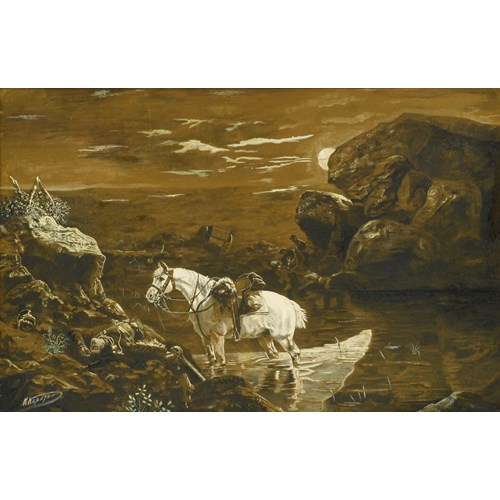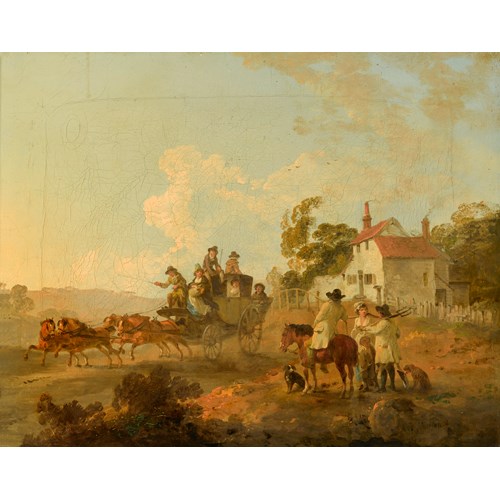Marketplace
Hayricks by the River
Mikhail Vasilevich Nesterov
Hayricks by the River
Epoque 1850-1900, 19th century, 20th century
Origine Russia
Medium Oil on board
Dimension 23.5 x 33.5 cm (9¹/₄ x 13¹/₄ inches)
This calming, cool and beautiful landscape is a typical example of Mikhail Vasilevich Nesterov’s celebrated work. Painted in broad swathes of green, the viewer’s eye is led back into the picture via bands of colour, until it settles on the distant field, dotted with stooks and surrounded by a thick, dark forest. The sky is clear, with the exception of a few wisps of cloud, and so a warm sunlight floods the scene. Although the view is a wide open one, it is flanked by banks of trees which contain the scene. The work is unified by Nesterov’s palette, which is dominated by shades of green, underpinned by areas of cool yellow and blue. However, within this relatively limited palette there is great variety which, thanks to Nesterov’s masterful skill, brilliantly models the light, conveying the depth of shadow created by the trees. There is also great variety in Nesterov’s painterly style, so there that are areas of thick impasto, contrasted with thinner areas where the grain of the board is visible.
Hayricks by the River is a typical example of Nesterov’s work, comparable to examples such as Landscape. Again the painting is dominated by a green palette, although in this example it is underpinned by brown, rather than the yellow and blue of the present work. Both paintings are executed with Nesterov’s characteristic broad fluid brushstrokes, and wide bands of colour.
Both the landscapes have similar topography, with their gently undulating fields and thick forests and it seems likely that both works depict the famous Abramtsevo estate. The estate, located north of Moscow, was originally owned by the author Sergey Timofeyevich Aksakov (1791-1859), who invited numerous writers and artists to discuss ways of ridding Russian art of its European influences. After Aksakov’s death it was eventually brought by the wealthy industrialist and art patron Savva Ivanovich Mamontov (1841-1918), under whom the estate flourished as one of the great artistic colonies of the nineteenth century.
Nesterov was born into a merchant family and went on to study at the Moscow School of Painting, Sculpture and Architecture from 1887-1881. He first stayed at Abramtsevo in 1884, and the landscape of the estate is central to much of his work. Here he also met and exchanged ideas with some of the most influential artists of the period and came into contact with the development of Russian Art Nouveau. Nesterov was a deeply religious man and tried to combine his Orthodox beliefs with this style. Many of his most famous works are narrative ones, but they are invariably set in the type of landscape depicted in Hayricks by the River. Artistically unique, Nesterov developed ‘a purposefully naïve, archaising style, mingling history, spirituality, idealism and mysticism...untroubled by creative insecurities.¹
In the 1880s and 90s Nesterov started to work in a range of genres. He executed many wall paintings for churches, such as those in St. Vladimir in Kiev. He also started to paint portraits, including those of some of the most notable cultural figures of the day. These were the works that helped him adapt to the huge cultural changes forced upon him by the Soviet regime, but his work continued to be acclaimed and he received a state prize in 1941, and the Order of the Red Banner of Labour in 1942.
¹ Jackson, David, The Wanderers and Critical Realism in Nineteenth-Century Russian Painting (Manchester University Press, Manchester, 2006), p.147.
Hayricks by the River is a typical example of Nesterov’s work, comparable to examples such as Landscape. Again the painting is dominated by a green palette, although in this example it is underpinned by brown, rather than the yellow and blue of the present work. Both paintings are executed with Nesterov’s characteristic broad fluid brushstrokes, and wide bands of colour.
Both the landscapes have similar topography, with their gently undulating fields and thick forests and it seems likely that both works depict the famous Abramtsevo estate. The estate, located north of Moscow, was originally owned by the author Sergey Timofeyevich Aksakov (1791-1859), who invited numerous writers and artists to discuss ways of ridding Russian art of its European influences. After Aksakov’s death it was eventually brought by the wealthy industrialist and art patron Savva Ivanovich Mamontov (1841-1918), under whom the estate flourished as one of the great artistic colonies of the nineteenth century.
Nesterov was born into a merchant family and went on to study at the Moscow School of Painting, Sculpture and Architecture from 1887-1881. He first stayed at Abramtsevo in 1884, and the landscape of the estate is central to much of his work. Here he also met and exchanged ideas with some of the most influential artists of the period and came into contact with the development of Russian Art Nouveau. Nesterov was a deeply religious man and tried to combine his Orthodox beliefs with this style. Many of his most famous works are narrative ones, but they are invariably set in the type of landscape depicted in Hayricks by the River. Artistically unique, Nesterov developed ‘a purposefully naïve, archaising style, mingling history, spirituality, idealism and mysticism...untroubled by creative insecurities.¹
In the 1880s and 90s Nesterov started to work in a range of genres. He executed many wall paintings for churches, such as those in St. Vladimir in Kiev. He also started to paint portraits, including those of some of the most notable cultural figures of the day. These were the works that helped him adapt to the huge cultural changes forced upon him by the Soviet regime, but his work continued to be acclaimed and he received a state prize in 1941, and the Order of the Red Banner of Labour in 1942.
¹ Jackson, David, The Wanderers and Critical Realism in Nineteenth-Century Russian Painting (Manchester University Press, Manchester, 2006), p.147.
Epoque: 1850-1900, 19th century, 20th century
Origine: Russia
Medium: Oil on board
Signature: Signed in Cyrillic (lower left)
Dimension: 23.5 x 33.5 cm (9¹/₄ x 13¹/₄ inches)
Plus d'œuvres d'art de la Galerie









